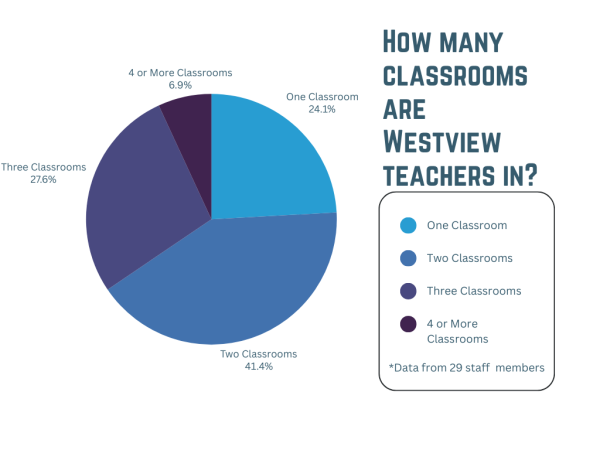This school year, Westview administration implemented the new classroom sharing policy, resulting in teachers now having to move around the school and share spaces with others. This new policy was established because of the growth of the student body, but also to promote collaboration.
The idea of teachers sharing spaces is not new. When the interviewing process for Westview was occurring, the philosophy of the school was a part of the conversation.
Academic Assistant Principal Ms. Pham said, “The philosophy, the focus of the school district is to ensure that this is our school, this is our building, this is our classroom. No one owns it. Everybody shares the classroom.”
The process of organizing courses here at Westview was done by a team of staff members known as the Instructional Leadership Team. This team consists of the Academic Assistant Principal, the Curriculum Specialists, the Director of Counseling, the Director of Special Education, and the counselors.
The Instructional Leadership Team wanted to ensure that “if a classroom is Science, it stays Science, if a classroom is Math, it stays Math, if a classroom is World Language, it stays World Language,” said Pham. “It’s content-specific class versus teacher-specific class,” she added.
Mrs. Myers, another member of the Instructional Leadership Team, talked about how at first having content-specific classes was the goal, however, that goal had to be shifted.
“We are committed to the PLC process and allowing our teachers to have a common plan. So, for example, all of our world language teachers have plan at the same time so that they can work together. Because of that, we had to kind of move away from that philosophy a little bit to make it work,” said Myers.
One main reason behind the focus on collaboration is that administration doesn’t want teachers to be teaching in silos, they don’t want them to be closed off from each other.
Having teachers collaborate and move around can benefit students. Content in one classroom can be spread to other classrooms. For example, an English teacher teaching their students about grammar can discuss with a Social Studies teacher about how they can include that grammar into their lessons.
This concept is known as interdisciplinary instruction. According to XQ Institute, Interdisciplinary Instruction allows students to make connections across classrooms and it prepares them for future jobs, communities, and college courses.
Interdisciplinary instruction is one of the benefits that can come with this new setup.
While this concept is meant to be beneficial, some teachers have experienced some drawbacks.
One common drawback that is shared amongst teachers is having all the supplies that they need to teach. Some teachers have to teach in one classroom while others have to teach in up to four. Making sure they have every supply that they need to teach their class can be difficult.
Freshman Seminar teacher Maggie Heuerman said, “It feels harder to stay organized sometimes being in different spaces.”
Heuerman is in three classrooms this school year and has faced the difficulties of having to switch classrooms.
Previously when she taught at Central High School, teachers also shared classrooms. However, it was done differently than what Westview does. At Central one teacher “owned” a classroom while newer teachers would move around.
At Westview, no one necessarily “owns” a classroom.
Since no one is in the classroom a majority of the time to take care of it, teachers have found that the room can tend to become untidy. Restroom sign-out sheets, tissues, sanitizer, and other basic needs for students aren’t as organized or available as they should be.
Another drawback that comes with no one owning the space is that teachers don’t feel like they can decorate their classrooms.

“It makes me show less of my personality through decoration as I have to collaborate with other teachers,” said World History teacher Breanna Wilkinson.
In some instances, courses with very different content may be in the same room resulting in a personality clash with the decorations. Since teachers don’t want to have the decorations clash and possibly look unorganized, they refrain from decorating their rooms.
Despite these drawbacks, teachers have been able to find some benefits within this new process.
One benefit of this process is that teachers are able to get around the school more and see people and areas that they might not usually see. When speaking about moving around the school, English teacher Madilynn Clinch said, “Moving [from 114] to 233 gets me out of the corner and allows me to see other teachers that I don’t normally.”
Teachers have said that moving around the school has allowed them to build better relationships with each other. This has also allowed for teachers to get new ideas that they normally wouldn’t if they were in their own classrooms.
Another positive that teachers have been able to find is that this new setup can also benefit students.
Since teachers are moving are the school, students are going to be in different structured classrooms around the school.
“If you’re constantly moving classes then they [students] have to be more flexible with seating and things like that, so I’d say there’s that benefit,” said World History teacher Matthew Moore.
Students and teachers will need to continue to adapt to moving classrooms.
“[We] will continue to fix and grow and accommodate and make changes that’s best for everyone,” says Ms. Pham.






















